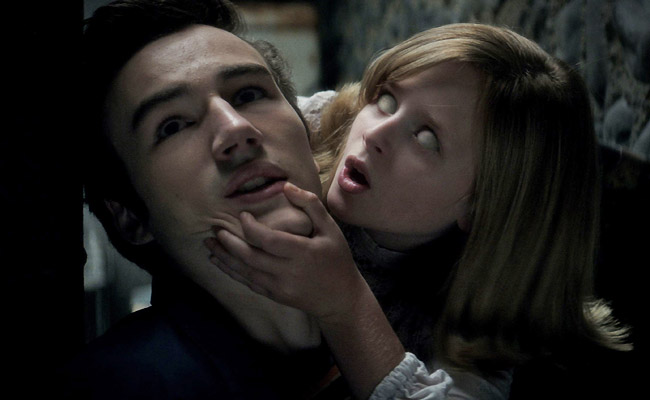
Universal Pictures
Horror movie fans, and movie fans in general, reacted quite negatively when Universal announced they would be bringing another board game to the big screen after the debacle that was 2012’s Battleship. But under the guidance of Jason Blum’s Blumhouse Productions (and the unfortunate participation of Michael Bay’s Platinum Dunes), the first Ouija movie wasn’t as bad as most people thought it would be. And it was successful enough to spawn a sequel … or rather prequel with Ouija: Origin of Evil.
In the original, a group of friends decide playing with a Ouija board is just silly fun, but when they contact the spirit of a young girl named Doris, things turn very badly. They discover photos and information on the family who previously lived in the house and track down Paulina Zander (Lin Shaye), the older sister of Doris, in a psychiatric hospital. She tells them their mother was a medium and used Doris as a vessel to communicate with the dead, then went mad and sewed Doris’ mouth shut. Paulina tells the kids where to find Doris’ body inside the walls and to unstitch her mouth to release the evil spirit of their mother. Except that was a lie, and the mother was trying to prevent the release of the evil contained within Doris … and Paulina was the one who stitched her sister’s mouth shut.
Ouija: Origin of Evil actually goes back in time to 1967 to show us the story of the Zander family and how introducing the Ouijia board into Mrs. Zander’s fortune telling business impacted the family. Everything that we knew peripherally from the first movie is here, but you don’t need to have seen that one to understand anything going on here. In fact, these two would play perfectly in viewing them in reverse order (although the actors playing the Zander family are different save for a post-credits tease featuring Lin Shaye in the hospital). The new film also deepens the story to show how the death of the Zander husband and father put the family into dire financial straits, and how easily Doris was taken over by the evil inside the house (which has a bit of a surprising history). There is also a priest, played by Henry Thomas, who is concerned about the children and tries to help (there is an obvious homage to the famous image of the priest outside the house from The Exorcist).
The film does a great job of evoking its 1960s era from hair to production design, and the cast is terrific. Elizabeth Reaser as the mother is a beautiful, loving woman who only wants to do right by her kids and her late husband. She knows what she does for a living isn’t real, but she has convinced herself — and Doris — that what they do actually helps people (older daughter Lina just thinks it’s a scam). Annalise Basso is also quite good as Lina, having the more difficult role of playing the skeptic and reacting to all the horrors going on around her. It’s nice to see Henry Thomas again, and even at 45 he is still unmistakably Elliot from E.T. the Extra-Terrestrial. The real star of the film, however, is young Lulu Wilson as Doris. Doris is a quite, completely innocent child, perhaps too innocent and trusting. But once she realizes her gifts, she wants to do nothing more than speak with all of her friends and help others speak to their departed loved ones. At one point during her possession, Wilson has one long interrupted stream of dialog that will leave you breathless and impressed that this child was able to pull it all off in a single take.
As for the scares, the film goes easy on them for the first half and, thankfully, refrains from amping up the sound effects and music to give the audience a fake jump. Unfortunately, things to get dialed up a bit later in the film, particularly that egregiously loud sound effects for lights turning off. Seriously, no light has ever been that loud when it was turned off. There are also some moments — like Lina sewing up Doris’ mouth — that may have benefited from an R-rating. All of the more violent moments that would have made the audience even more horrified happen off camera. The real scares are actually rather mild, but they take one back to the classic horror films of the past where what you thought you saw was more frightening than what was actually on screen (although having Doug Jones play two of the evil spirits really ups the scare factor), and quite often without a lot of CGI trickery except in the obvious cases involving facial distortions.
Ouija: Origin of Evil may not be as scary as any of the Conjuring or Insidious films, but it still shows that old school horror can still be done, and done well, for modern horror movie fans.

I been watching this show in morning and night I HAVE NIGHTMARES and NO ONE PLAY THIS GAME PLZZZZ?